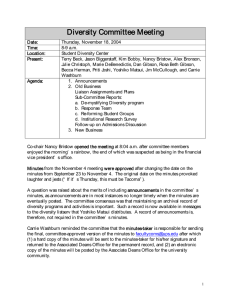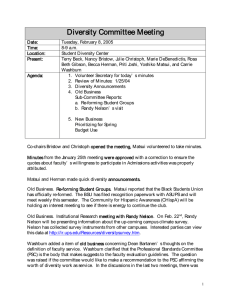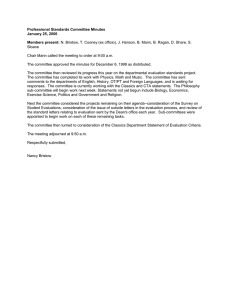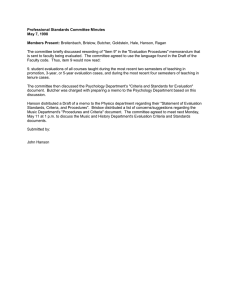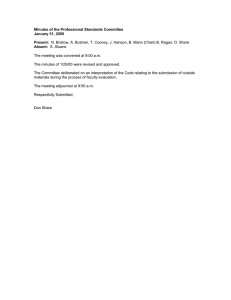Diversity Committee Meeting
advertisement
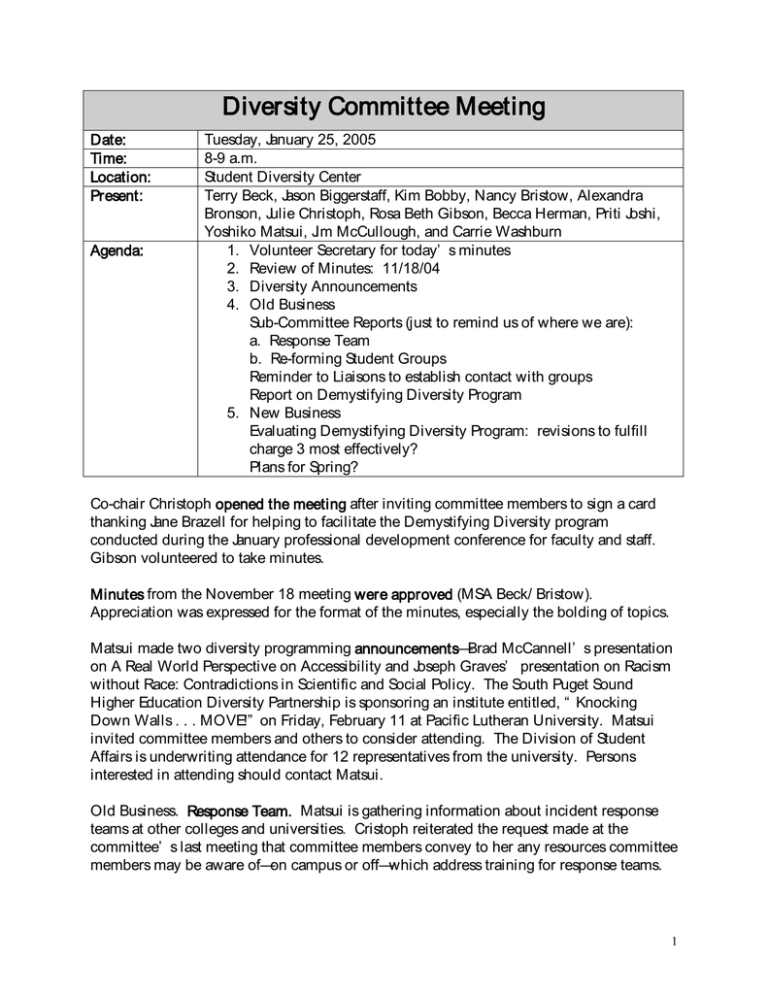
Diversity Committee Meeting Date: Time: Location: Present: Agenda: Tuesday, January 25, 2005 8-9 a.m. Student Diversity Center Terry Beck, Jason Biggerstaff, Kim Bobby, Nancy Bristow, Alexandra Bronson, Julie Christoph, Rosa Beth Gibson, Becca Herman, Priti Joshi, Yoshiko Matsui, Jim McCullough, and Carrie Washburn 1. Volunteer Secretary for today’ s minutes 2. Review of Minutes: 11/18/04 3. Diversity Announcements 4. Old Business Sub-Committee Reports (just to remind us of where we are): a. Response Team b. Re-forming Student Groups Reminder to Liaisons to establish contact with groups Report on Demystifying Diversity Program 5. New Business Evaluating Demystifying Diversity Program: revisions to fulfill charge 3 most effectively? Plans for Spring? Co-chair Christoph opened the meeting after inviting committee members to sign a card thanking Jane Brazell for helping to facilitate the Demystifying Diversity program conducted during the January professional development conference for faculty and staff. Gibson volunteered to take minutes. Minutes from the November 18 meeting were approved (MSA Beck/ Bristow). Appreciation was expressed for the format of the minutes, especially the bolding of topics. Matsui made two diversity programming announcements—Brad McCannell’ s presentation on A Real World Perspective on Accessibility and Joseph Graves’ presentation on Racism without Race: Contradictions in Scientific and Social Policy. The South Puget Sound Higher Education Diversity Partnership is sponsoring an institute entitled, “ Knocking Down Walls . . . MOVE!” on Friday, February 11 at Pacific Lutheran University. Matsui invited committee members and others to consider attending. The Division of Student Affairs is underwriting attendance for 12 representatives from the university. Persons interested in attending should contact Matsui. Old Business. Response Team. Matsui is gathering information about incident response teams at other colleges and universities. Cristoph reiterated the request made at the committee’ s last meeting that committee members convey to her any resources committee members may be aware of—on campus or off—which address training for response teams. 1 Old Business. Reforming Student Groups. Matsui reported that last semester’ s dialogue meetings with students of African descent enabled participants to air perspectives and points of view. Students are now talking about when to start. Old Business. Reminder to Liaisons to establish contact with groups. Christoph encouraged committee members serving as liaisons to contact student groups if they haven’ t already done so. Because spring semester meeting times may be different from fall semester meeting times, Herman distributed a consolidated schedule of student groups’ meeting times. Student groups started meeting during the week of January 24. Committee members were reminded that two new student groups were formed this year— the Muslim Student Association and a First Nations student group. Bristow indicated that she will be the liaison to the First Nations group. Bristow asked the students present whether the Diversity Committee should reconsider its meeting time because students are less likely to attend an 8 a.m. meeting than one that’ s scheduled later in the day. The challenge, of course, is that faculty members’ teaching schedules are such that any other meeting time would prevent them from attending meetings at any other time. The consensus of the committee members present was that the work of the liaisons might help to insure that students’ interests and concerns are heard and brought to the 8 a.m. Tuesday meetings. Washburn added an item of old business, reporting that Academic Vice President Kris Bartanen had finalized the memo drafted by Director of Freshman Admission Melanie Reed inviting faculty members to participate in admission activities and programs to promote the recruitment of students of color to attend Puget Sound. Dean Bartanen presented the memo to the academic department chairs for discussion, after which she sent the final edition to all members of the faculty in a December e-mail message. Faculty members on the committee expressed appreciation for the tone and content of the memorandum. Bristow and Christoph, who expressed appreciation to Dean Bartanen on behalf of the committee for the memorandum, will ensure that members of the committee who did not receive the memo as members of the faculty will get copies of the document. Bristow indicated that, based on her own experience, our admission colleagues will immediately follow up with faculty who respond to the invitation to partner with admission. It will be important for admission staff to maintain data about faculty participation so that they can report to the Dean and to the faculty that, for example, X number of faculty participated in activities and programs A, B, C, etc. The Diversity Committee will encourage admission staff to begin to maintain such data if they don’ t already do so. Such data will enable the administration to thank the faculty both individually and collectively for their university service in this area. If we have more students of color next fall, we want faculty to notice that change and to recognize that their service may well have made a difference. 2 It was reported that some faculty colleagues are not viewing the memo as representing a serious attempt on the part of the university to diversify the Puget Sound community. The perspective of those expressing concern is that the administration is giving lip service to diversity and is not using the right approach, though no alternative approaches are being offered. Bristow noted that such a reaction to the memo might be founded in past experience, a sense that this initiative might be another in a series of initiatives that doesn’ t address the challenge but dismisses it. Discussion followed regarding faculty service and where such aspects of service as supporting admission staff in recruiting students of color fit in the university’ s culture and faculty advancement process. Perspectives, questions, and suggestions included: Committee membership, not an easy task, is what really counts as university service. Is university service something that is evaluated or simply checked off if, for example, the faculty member has served on a university committee? Evaluative criteria change behavior. Forms of university service like partnering with admission must be institutionalized in the form of evaluative criteria. What activities do we want faculty to engage in and get credit for? In order for meaningful service other than committee membership to be counted, departments need to acknowledge other forms of service in departmental guidelines/standards for university service. The acknowledgement needs to be specific, not vague. It’ s important to note, however, that departmental guidelines/standards were rewritten recently for the first time in twenty years and it’ s therefore unlikely that they will be revisited soon. It is important to note that individual faculty members can offer service more readily at some times than at others. Individual faculty members need help to know how to answer the question, “ What that I’ m now doing, am I not supposed to do in order to serve the university in these ways?” The importance of defining meaningful service outside of committee membership should be raised with the Professional Standards Committee with an invitation that the PSC interpret what university service guidelines/standards mean—how do we interpret what is significant service? Might the Diversity Committee ask the PSC to consider this a charge for the 2005-2006 year? Might co-chairs Bristow and Christoph write to Dean Bartanen recommending that this be a charge to the PSC? Should the Diversity Committee send a letter to the Faculty Senate because it’ s the senate that establishes committee charges? Should the Diversity Committee consult with the Advancement Committee to find out what they are seeing in the area of university service? It’ s important to consider not only the ways in which faculty can support the recruitment and retention of students of color, but also the ways in which faculty can and do support diversity initiatives in advising, professional development, research, pedagogy, etc. We need to broaden our use of evaluation guidelines to include a comprehensive range of diversity service. 3 Washburn, as Dean Bartanen’ s representative on the committee, will share the committee’ s discussion and questions with Dean Bartanen and solicit her advice regarding next steps. Old Business. Report on Demystifying Diversity Program and New Business. Evaluating Demystifying Diversity Program: revisions to fulfill charge 3 most effectively? Christoph reported that the session that she, Bristow, and Jane Brazell facilitated during the professional development conference for faculty and staff was sparsely attended but productive. The program was organized around the university diversity statement. The section of the program on the “ we act” segment of the statement was the most significant because of invigorating discussion about case studies. The hourand-a-half time period for the session didn’ t provide sufficient time and, as noted earlier, there were not enough people in attendance. Some of those who had registered for the session were unable to attend. If the committee does the session again in the future, the description of the program in the marketing material needs to be rewritten. Gibson reported that other diversity-related programs were also sparsely attended and that one session was canceled by the external presenter. With respect to future efforts to fulfill the committee’ s charge to “work with the Office of Human Resources and the Division of Student Affairs to develop and implement additional educational programs promoting awareness of and support for the values articulated in the University Diversity Statement and the proposed Campus Policy Prohibiting Harassment” the committee identified the following possibilities: Request that President Thomas select diversity as his topic for the fall faculty conference. The committee noted that this event is the president’ s, that it is he who decides what he wants faculty input on, and that the committee might serve informally (perhaps by inviting President Thomas to lunch) to influence what he chooses to focus on at the conference. Consider both captured and voluntary audiences and the implications of the commitment differences between them. Use existing forums like the race and pedagogy discussions, perhaps with more presentations and fewer discussions. Recognize that the university will be hosting a national conference in the fall of 2006 on race and pedagogy and that faculty development and curriculum development in the area of race and pedagogy will be a significant focus at Puget Sound for the next year and a half. Faculty will be provided opportunities through summer development grants, for example, to explore these matters prior to the conference so that Puget Sound faculty can serve as experts during the conference. Conduct a scan of what’ s currently being done throughout the university in the way of “ educational programs promoting awareness of and support for the values articulated in the University Diversity Statement and the proposed Campus Policy Prohibiting Harassment,” perhaps by gathering a group from Human Resources, the Division of Student Affairs, and the Division of Academic Affairs. It’ s important to note that the diversity statement applies even if one is not actively teaching. 4 Acknowledge that the several series of lectures on campus annually are an important “ educational program” component. Acknowledge that what happens in the classroom is at the crux of all aspects of the diversity statement. Is that reality reflected in the evaluations students complete? Even though diversity is not directly addressed in the evaluation process, students will often raise diversity issues in negative rather than positive ways (e.g., the faculty member spent too much time during the semester on women’ s issues). It’ s important to note that the Faculty Senate is currently working on reviewing the student evaluation process. Conduct a scan of departmental guidelines/standards for university service. Look for strengths (e.g., John Lear’ s development of the Latin American Studies program) and celebrate those. Build on our successes. Consider an educational model that brings white folks together in the room. Celebrate the connections between people at all levels; celebrate what defines us as individuals; use the “ I Am Puget Sound” program to support our relating to one another through both our differences and our similarities. New Business. Plans for Spring? Committee members were encouraged to think about what couple of activities should be the productive focus of the committee’ s spring term meetings. Spring term activities might include the scan described above and working with Director of Institutional Research Randy Nelson who will be developing a campus climate survey for the fall of 2005. Herman volunteered to bring a digital camera to the next committee meeting for a photo shoot, the results of which will be added to the Student Diversity Center gallery. MSA (McCullough/Joshi) that the meeting adjourn at 9:04 a.m. Action Items Item Contact student clubs and organizations; schedule attendance at first meeting of spring semester Send November 18 meeting minutes to facultycoms@ups.edu Discuss next steps in defining/promoting university service with Dean Bartanen Bring camera to next meeting Identify two aspects of our charges to focus on during the remainder of the spring term and prepare to discuss them at the next meeting Next Meeting: Person Responsible Each committee member with liaison responsibilities who hasn’ t already done so Gibson Washburn Herman Each committee member Date Due ASAP Done on January 25 February 8 February 8 February 8 Tuesday, February 8, 2005, 8 to 9 a.m., Student Diversity Center 5 Respectfully submitted, Rosa Beth Gibson 6
